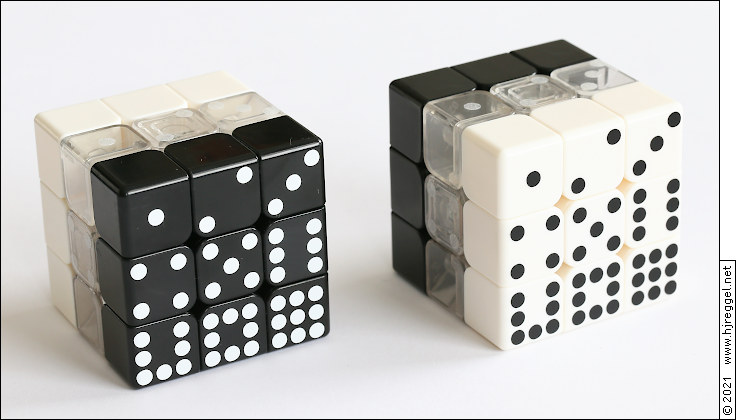 | |
| A pair of 3×3×3 Domino Cubes: Layers by color, permutation by domino dots, leading black and leading white face | |
funCUBING Index Page · funCUBING Projects · The Domino Project
For information on the original 3×3×2 Domino, see The Vintage Rubik's Domino .
The original Rubik's Domino plays with determination. A twisty puzzle is considered "solved" if all visible pieces are in the intended place and the intended orientation. If pieces can be placed in different spots, or in more than one orientation, without being able to notice the difference, the puzzle is under-determined. Regular 3×3×3 cubes, for example, are under-determined regarding center rotation. If pieces contain more information about placement or orientation than necessary, the puzzle is over-determined. For example, a mirror cube with a six-color scheme and the same color on each face when solved by shape is heavily over-determined. You can either look at the size or the color to know where and how to put a piece.
If we look at only one layer of the Rubik's domino, i.e. cubies of the same color, the placement is determined by the sequence of numbers, as long as we have the same sense of sequence and placement. There's no need to check information from the sides of the cubies. This does not only apply to the Domino, where the cubies can't be oriented (as some think). If the cubies could be oriented, you would know that all marked cubie faces must show on a common plane.
Even this is slightly over-determined, because corner pieces and edge pieces are on different orbits. However, there must be a hint of how these two sets shoud be arranged relative to each other. As an example, you could number corners from 1 to 4, and edges from 1 to 4, and say that corners come before edges. Then you'd get 1-1-2, 4-O-2, 4-3-3 (even with a blank center). But that would be too much to guess to solve it intuitively.
I have been thinking for a long time, how to apply the "Domino Principle" to a 3×3×3 cube. First, I tried to come up with a way to mark the sides across the three layers so that the placement and orientation of the four middle layer edges would be fully determined, together with the rotation relative to the upper and lower half. But I could not come up with a reasonable, and yet minimalistic way of doing so.
A very simple solution would be to use numbers from 1 to 12 along the equator, but what would be the correct direction (clockwise or anti-clockwise)? And what would be the correct orientation relative to the upper and lower layer?
Another idea was to mark only certain faces on all three layers around. Start with 1 at the side of the top corner cubie with number 1 on top, 2 on the center, 3 on the adjacent edge face, then skip to 4 on the next face center, 5 on the adjacent edge face. Then we end with 8 on the last center, 9 on the adjacent edge face. The first two layers can have the same color, as the sequence starts in the top layer and then continues on the middle layer. The edge pieces in the middle layer cannot be confused with the ones in the top layer, because top edge pieces are numbered 2, 4, 6, and 8, while the middle layer edge pieces would be numbered 3, 5, 7, and 9. The orientation of the bottom layer would be relative in the same way as on the original Rubik's Domino. But all in all, where's the symmetry?
What about the color of the middle layer? Well, the original Rubik's Domino has a "leading face" with sequence 1-2-3. So it would be OK if the middle layer would be the same color as the leading face. All marked side cubies would have the same color, all sides of the opposite color cubies will remain blank.
When I started to think about the topic again after a long time, all over sudden everything was clear in my mind.
The Domino Principle is an imaginary projection from the leading face throughout the whole cube to the opposite face. Each cubie in such a column has the same number as on the leading face. To make the number visible on the outside, the number will be displayed on the face where the longest sequence of consecutive numbers is possible. The orientation of the dot pattern is as if you would rotate the top cubie face towards the respective layer. For the cube orientatoin, we assume the black or white sides being top or bottom, with 1-2-3 in the back row. The numbers in the horizontal middle layer read 1-2-3 on the back, 4 on the left (not 1-4-7), 6 on the right (not 3-6-9), and 7-8-9 on the front. The number 5 relates to the core, and is not shown on the outside.
As the middle layer is in the middle, there is no need to indicate to which half ob the cube the cubies belong. The middle layer must not have any color, it has to be clear, or at least something like that. The dots as well can't be black or white, they have to be clear, too - but a slightly different type of clear than the cubies.
Voilà, my masterpiece, a pair of 3×3×3 Domino Cubes (leading black and leading white side), built in May 2021.
 | |
| A pair of 3×3×3 Domino Cubes: Layers by color, permutation by domino dots, leading black and leading white face | |
But the Story continues: Building a 4×4×4 Domino Cube
funCUBING Index Page · funCUBING Projects · The Domino Project · Top of Page